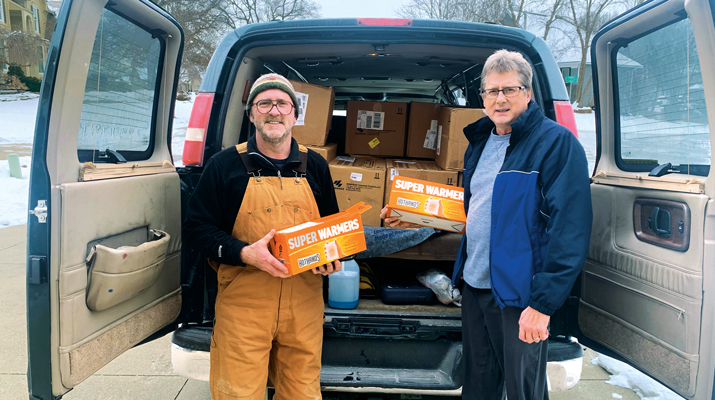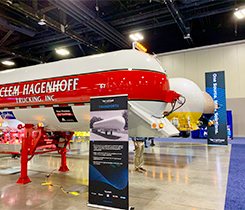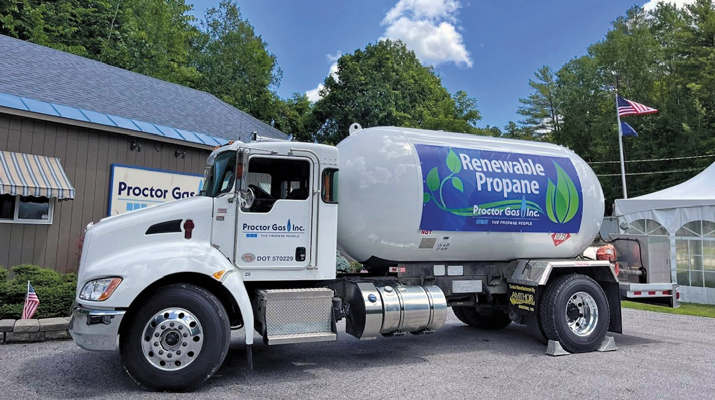The Open Road
 |
Propane’s recreational vehicle segment is steadily growing, as aging baby boomers with disposable incomes are taking to the highways in well-appointed style.
Because almost every self-contained motorhome or towable trailer camper comes equipped with propane-powered appliances, propane marketers pursuing this niche are gaining sales in both the gas itself and in road warrior-related propane accessories. And this category shows no signs of slowing down despite high gasoline prices. A post 9/11 stay-closer-to-home mood and favorable demographic trends are likely to drive RV traffic for years to come.
 Recreational Vehicle Market For Propane |
“The RV market has been growing aggressively, with a corresponding growth in propane demand,” a study produced for the Propane Education & Research Council reported. Since 1998, RV propane consumption has increased 2.7 percent each year.
“It’s good, steady growth, and it’s been steady growth for a while,” says PERC consultant Mike Sloan, project manager for Energy and Environmental Analysis Inc. of Arlington, Va.
“Any growth market is a growth market, and this is something that will help you grow your sales a little bit,” says Sloan. “There’s still a fair amount of cash out there that people are spending on RVs, and propane is still the fuel of choice.”
RVs account for the second-largest cylinder refill market — 20-lb. barbecue grilling remains Number One — as some 150 million gallons are pumped annually.
In the southern United States, RV-based propane consumption “is a year-long load, which makes it attractive to us,” says Tom Killmer, national account manager for Suburban Propane, which is an endorsed provider to members of the Recreation Vehicle Dealer Association. “In the Northern tier, most of the demand is in the summer — which is our off-season.”
The company’s RV segment grew 26 percent in 2004, and it’s expected to expand by some 25 percent to 30 percent this year, according to Killmer. “It’s a pretty good growth industry,” he says, citing the upscale atmosphere that RV-ing has become. RV-specific resorts have been developed, complete with restaurants, golf courses and swimming pools.
Swimming pool heaters are fueled by propane, as are patio heaters, grills and other appliances that bring the comforts of home outdoors. “If you have a million-dollar rig, you don’t want to pull into a cow pasture like it used to be in the old days,” Killmer says.
A quite bright future
The number of RV-owning households will rise to nearly 8 million in 2010, a gain of 15 percent between 2001 and 2010. That outpaces the overall American household growth rate of 10 percent, according to Dr. Richard Curtin, director of the Survey Research Center at the University of Michigan.
Nearly one in 12 households in the United States currently owns an RV, amounting to nearly 7 million households — an increase of 7.8 percent from 1998 to 2001, according to a UM study commissioned by the Recreation Vehicle Industry Association (RVIA).
A leading force behind the upswing in RV ownership is the baby boomer market of consumers 35 to 54 years old, the survey reports. From 1998 to 2001, the number of RVs owned by those 35 to 54 grew faster than all other age groups, “underscoring the success of industry marketing efforts aimed at the baby boomer,” says Curtin. Almost 10 percent of those 55 and over own an RV, slightly exceeding the 8.9 percent ownership rate of 35-to-54 year olds.
The average RV owner is married, owns a home and has an annual household income of $56,000, compared to the national average of $41,994. Reflecting the aging population, the median age of all RV owners is now 49 years, up slightly from a previous study, which recorded a median age of 48.
“Primary RV demand is very good and the potential for future sales quite bright,” Curtin says.
Customer convenience at the pump and promotional activities related to the camping/vacation industry and RV dealer/manufacturer realm are critical elements for reaching these well-heeled yet value-conscious consumers.
“As a marketer you may want to have tie-ins with the sellers,” says Sloan. “So I’d be trying to get name recognition with the RV dealers.” Placards and other advertisements gracing the showroom floor will attract attention, as will offers such as coupons good for a tank or two of propane, he suggests.
Selling a fuel cell
At the bigger-picture level, Sloan and others encourage the industry to work closely with RV OEMs to ensure that propane is the primary auxiliary fuel affixed to the vehicles as they roll out the door. Diesel generators are making some inroads in the marketplace, especially with grand motorcoaches that can sell for upwards of $500,000 to $1 million.
Currently under development is a propane-powered fuel cell aimed at RVs and 18-wheeler rigs endlessly idling at truck stops. A rollout is projected for sometime in 2006.
“This is a pretty cool deal as far as RVs are concerned because they already have propane on board,” says Dan Kelly, director of AFRED, the Alternative Fuel Research and Education Division of the Texas Railroad Commission. A grant of $499,000 from the Texas Commission on Environmental Quality’s New Technology Research and Development Program is steering the project forward.
“We see this as an opportunity for the LP gas industry,” says Nick Ballinger, co-founder of Clean Fuel Generation LLC of Los Angeles. The company is producing the fuel processor (also called a reformer) that converts propane into hydrogen for the device. Teledyne Energy Systems of Hunt Valley, Md. also is involved with the effort.
“The RV industry is very excited about the technology and waiting to get it,” Ballinger says. “We’ve had discussions with several RV companies and they’re showing interest.”
RV owners are looking for a clean, quiet power source, and they are viewed as a segment likely to embrace the debut of a commercial fuel cell. It’s anticipated that a 5-kilowatt unit would cost about $7,500 at the consumer level. The RV channel’s high incomes and extended financing terms make this an attractive place to start.
“It’s a good introductory market for fuel cells,” says Ballinger. Acceptance among RV-ers will assist in ramping up production and thus lowering the price points, he believes.
The tractor-trailer market for a propane-powered fuel cell is equally intriguing, as it would significantly reduce diesel pollution caused by truckers continuously idling their rigs to power in-cab auxiliaries.
User-friendly fueling
For propane marketers catering to RV-ers, pump placement is seen as a main factor in determining your success at attracting this niche and keeping it coming back.
“Plan on making propane use convenient for the RV drivers,” Sloan says. “Make it easy and quick for the RVs to fill their tanks — that’s the key issue.”
Where to stick the spigot is a detail frequently overlooked by propane marketers when setting up an RV center, according to Robert Jacobs, vice president for retail operations at Delta Liquid Energy, based in Paso Robles, Calif.
“People install dispensers without considering the size of a motorhome,” he says. “It’s important where you locate the dispenser. That leads to a lot of our success” at reaching RV owners, which accounts for half of the propane pumped at the Paso Robles location.
“You have to provide good access and egress,” he says. “Some of these [vehicles] are 40 feet long.”
Providing stellar customer service by adequately trained employees is another main factor driving Delta’s RV trade. “At some service stations there’s only one guy in the store, and the last thing he wants to do is fill up an RV,” Jacobs says. “When our staff inside sees an RV roll up, they go out to greet them.”
Transactions are handled as efficiently as possible with a minimum of waiting. “They’ll hop back into their coach and drive out — getting fuel is user-friendly.”
Such strategies draw return visits, and word of a positive experience at Delta is spread around to other RV-ers, according to Jacobs. “That’s an important part of our locations, and that brings a lot of RV business,” he says
Most of the company’s RV customers are area residents preparing to embark on vacation. “Before they take a trip they’ll come in here to fill their tank,” says Jacobs. Advertisements have been placed in camping publications, but Jacobs says, “you get a good word-of-mouth” when good service is discussed amid the camaraderie enjoyed while sitting around the campfire.
Two of Delta’s nine facilities sell RV parts and accessories; the Paso Robles outlet boasts of the largest such selection in the northern part of the county. Propane on the road is used for hot water, cooking, heating and refrigeration.
“It’s a very valuable source of propane for revenue for any propane marketer,” Jacobs says.
Casting a wary eye toward diesel generators on board some of the larger RVs, Jacobs — a member of PERC’s agricultural advisory committee — plans to encourage the association to formulate an advertising campaign geared toward the camping component.
“Maybe they should throw some ads at the RV segment,” he says. “This is a sector that we have and we don’t want to lose it. Everything on that coach [currently] runs on propane. We should maintain that; this is something to protect. As an industry, we should keep that option open for people.”
A lucrative portion
An estimated 30,000 gallons of propane is sold annually to RV-ers at the FerrellGas facility in Bend, Ore., according to Darrell Gray, the general manager. “It’s a lucrative portion” of the outlet’s business with a decent profit margin, he says.
“This is a tourist town, so we get a lot of people coming through. Just word-of-mouth and service” is the best advertising, Gray says. “We don’t do any mass marketing, but we have a good supply of parts and hoses.”
However, he does suggest that propane marketers venturing into this segment network with the various associations catering to RV enthusiasts, campground owners and others serving the industry.
As with Delta, proper training and attentive customer service are Gray’s key goals. “We always have someone available who knows what they’re doing instead of some high school kid who’s just pumping gas,” he says.
















